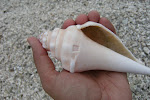I really wanted to keep my pieces closely resembling ancient Chamorro ornaments but my best friend said I should try experimenting with a few “not-so traditional pieces.” There are some people on Saipan that are big into making jewelry out of beads and they turn out real quality work that you can sell at high end stores on the island. But I really wanted an emphasis on a “traditional” flavor. As I see it, anyone can order bulk beading materials and get a book or video that gives you instructions on how to produce really good looking pieces. I am not knocking anyone who does this (in fact it’s a pretty neat hobby) but I think I will stick to utilizing things that I cut myself and not resort to store bought beads, etc.
This is the first bracelet that I attempted with a beautiful orange Spondylus centerpiece. The centerpiece reminds me of some Palauan money beads that are in the same shape and color. I then alternated two uncommon purple colored Spondylus salape’ disc beads, two orange ones, and closed the bracelet off with another purple salape’ bead. This was my first attempt on a bracelet form utilizing a square (flat) braid and a loop & toggle for the closure. I think I will rebind this another day, because the loop & toggle style on this bracelet makes it a little hard to put on by yourself. My best friend (who owns this piece now) struggles a few moments before she can get it on her wrist.



 This next bracelet I call Cinnamon. It is made up of two orange Spondylus salape’ beads and the center bead is of an uncommon cinnamon colored Spondylus. This beauty is one of a kind!
This next bracelet I call Cinnamon. It is made up of two orange Spondylus salape’ beads and the center bead is of an uncommon cinnamon colored Spondylus. This beauty is one of a kind! 

My best friend saw some beads from a tiger cowry (Cypraea tigris) that were cut into squares in a gorgeous piece that was put together with some glass and plastic beads. She convinced me to experiment with this very non-traditional shape and I think the piece turned out attractively. I complained the whole time I was cutting it though saying things like, “This is not a traditional shape!” and telling her that the tiger cowry was probably over fished where it came from, and that if I wanted to be a “beader” then I should stop cutting my own pieces, and so on and so forth. So I ended up calling this piece Tigiri, the Chamorro word for tiger (from the Spanish word tigre, of course). Look closely and you’ll see Tigiri’s stripes.

 Thank you again for allowing me to share.
Thank you again for allowing me to share.


4 comments:
Your first bracelet turned out looking good. I Like the round bead on the Tigiri and all around looks good even with square ones.
Aside from human bone, were shells also cut into fishing hooks?
Got a MTB? Lets ride, dude...
Lewie: Unfortunately my MTB was stolen and have to stick with being a roadie for now. Actually, sad to say, I haven't ridden since my car accident in May!
Ancient Chamorro hooks will be a topic for the very near future. Bone was definitely used. The more commonly found hook artifacts are made from the tree oyster shells of the genus Isognomon. Pearl oysters of the genus Pinctada and the shell of the haggan (sea turtle) were also fashioned into compound hooks (of multiple parts or different materials composing one hook).
Thanks for the compliments and I’m glad that you like the designs. I want to put some more design concepts together before I start selling so keep tuned in!
beautiful bracelets! Nice and polished.
I admire your dedication to using traditional materials for these beautiful bracelets.
Post a Comment